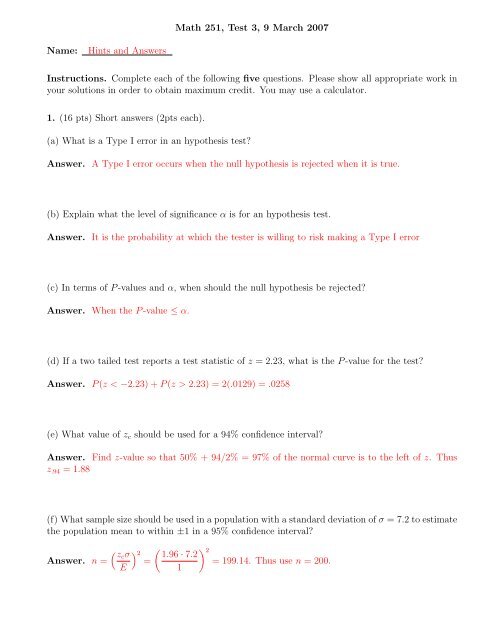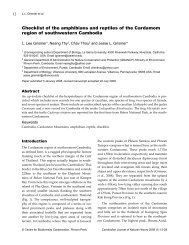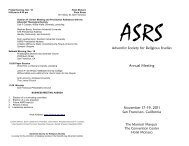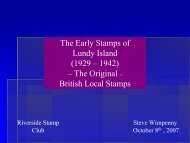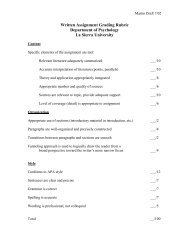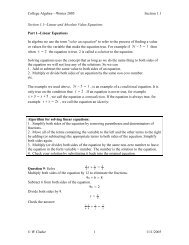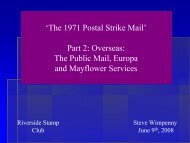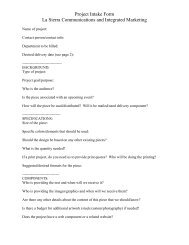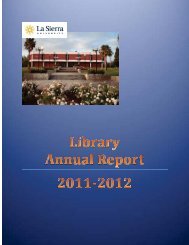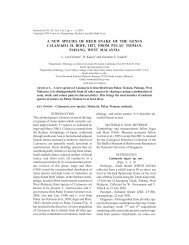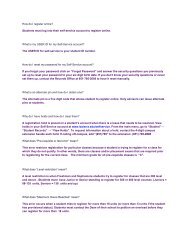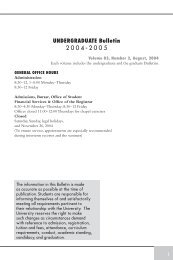Test 3 - Faculty.lasierra.edu
Test 3 - Faculty.lasierra.edu
Test 3 - Faculty.lasierra.edu
Create successful ePaper yourself
Turn your PDF publications into a flip-book with our unique Google optimized e-Paper software.
Math 251, <strong>Test</strong> 3, 9 March 2007<br />
Name:<br />
Hints and Answers<br />
Instructions. Complete each of the following five questions. Please show all appropriate work in<br />
your solutions in order to obtain maximum credit. You may use a calculator.<br />
1. (16 pts) Short answers (2pts each).<br />
(a) What is a Type I error in an hypothesis test<br />
Answer. A Type I error occurs when the null hypothesis is rejected when it is true.<br />
(b) Explain what the level of significance α is for an hypothesis test.<br />
Answer. It is the probability at which the tester is willing to risk making a Type I error<br />
(c) In terms of P -values and α, when should the null hypothesis be rejected<br />
Answer. When the P -value ≤ α.<br />
(d) If a two tailed test reports a test statistic of z = 2.23, what is the P -value for the test<br />
Answer. P (z < −2.23) + P (z > 2.23) = 2(.0129) = .0258<br />
(e) What value of z c should be used for a 94% confidence interval<br />
Answer. Find z-value so that 50% + 94/2% = 97% of the normal curve is to the left of z. Thus<br />
z .94 = 1.88<br />
(f) What sample size should be used in a population with a standard deviation of σ = 7.2 to estimate<br />
the population mean to within ±1 in a 95% confidence interval<br />
Answer. n =<br />
( zc σ<br />
E<br />
) ( ) 2 2 1.96 · 7.2<br />
= = 199.14. Thus use n = 200.<br />
1
1.(g) What is the standard deviation for the sampling distribution of ¯x based on samples of size<br />
n = 64 for a population with a standard deviation of 18<br />
Answer. σ¯x = σ √ n<br />
= 18 √<br />
64<br />
= 18<br />
8 = 9 4 = 2.25<br />
(h) What sample size should the Gallup organization use if it wishes to estimate the percentage of<br />
Americans who support troup escalation in Iraq to an accuracy of plus or minus 3 percent 19 times<br />
out of 20<br />
Answer. n = 1 4<br />
( zc<br />
) 2 1 =<br />
E 4<br />
( ) 2 1.96<br />
= 1067.1. Thus use n = 1068.<br />
.03<br />
2. A recent poll reported that 23% of adult Americans surveyed approve of the way the United<br />
States has handled the war in Iraq. Moreover, the polling organization reported their methods were<br />
as follows.<br />
“These results are based on telephone interviews with a randomly selected national sample of 1,006<br />
adults, aged 18 and older, conducted Feb. 24-26, 2007. For results based on this sample, one can<br />
say with 95% confidence that the maximum error attributable to sampling and other random effects<br />
is ±3 percentage points. In addition to sampling error, question wording and practical difficulties<br />
in conducting surveys can introduce error or bias into the findings of public opinion polls.”<br />
(a)(2 pts) What is the confidence interval that polling organization is suggesting for the proportion<br />
of adult Americans favoring the way the U.S. has handled war in Iraq<br />
Interval: .20 < p < .26 Level of Confidence: c = .95<br />
(b) (3 pts) Find a 99% confidence interval for the proportion of adult Americans that approve of<br />
the way the United States has handled the war in Iraq.<br />
Ans: .1958 < p < .2642<br />
√<br />
(.23)(.77)<br />
First, z c = 2.58 and E = 2.58<br />
≈ .0342. The endpoints of the interval are then .23±.0342.<br />
1006<br />
Therefore,<br />
.1958 < p < .2642 with 99% confidence<br />
(c) (1 pt) Explain (or show) why the conditions necessary for constructing a confidence interval on<br />
a proportion are satisfied in this case.<br />
Answer. Because both np ≈ (1006)(.23) > 5 and nq ≈ (1006)(.77) > 5.
3. Suppose the mean life span of English Springer Spaniel dogs is normally distributed with a mean<br />
of 13 years and a standard deviation of 1.5 years.<br />
(a) (2 pts) What is the probability that a randomly selected English Springer Spaniel will live to be<br />
14 years or older<br />
Ans: .2514<br />
Answer. P (x > 14) = P<br />
(<br />
z ><br />
)<br />
14 − 13<br />
= P (z > .67) = 1 − .7486 = .2514<br />
1.5<br />
(b) (2 pts) What is the probability that a randomly selected sample of 25 English Springer Spaniels<br />
will have a mean life span of 14 years or more<br />
Ans: .0004<br />
Answer. P (¯x > 14) = P<br />
(<br />
z ><br />
)<br />
14 − 13<br />
= P (z > 3.33) = 1 − .9996 = .0004<br />
1.5/5<br />
(c) (2 pts) What is the probability that a randomly selected sample of 25 English Springer Spaniels<br />
will have a mean life span between 12.5 and 14 years<br />
Ans: .9521<br />
( 12.5 − 13<br />
Answer. P (11.5 < ¯x < 14) = P<br />
1.5/5<br />
.9521<br />
)<br />
< z < 3.33 = P (−1.67 < z < 3.33) = .9996−.0475 =<br />
4. A government official wishes to determine if there has been “grade inflation” for graduating seniors<br />
in her state’s high schools over the last 10 years. So she took random sample of 900 graduating<br />
seniors GPA’s in 1996 and found the sample to have a mean GPA of 3.13 and a standard deviation<br />
of .56, and she found a sample of 1225 graduating seniors in 2006 had a mean GPA of 3.29 with a<br />
standard deviation of .53.<br />
(a) (3 pts) Help this official by constructing a 99% confidence interval for the difference of the<br />
population means, use the 1996 GPA’s as population 1. Assume the standard deviations given are<br />
also the population standard deivations.<br />
Ans: −.222 < µ 1 − µ 2 < −.098<br />
Answer. E = 2.58<br />
√<br />
(.56)<br />
2<br />
900 + (.53)2<br />
1225 ≈ .062. The endpoints of the interval are ¯x 1 − ¯x 2 ± E and so<br />
−.222 < µ 1 − µ 2 < −.098 with 99% confidence.<br />
(b) (2 pts) Describe in words (like a news reporter) what the inveral in (a) means.<br />
Answer. We are 99% confidenct that the average GPA of high school graduates in the state in<br />
1996 were .222 to .098 lower than the average GPA of high school graduates in the state in 2006.<br />
(c) (1 pt) Based on your answer in (a), would you be convinced that there has been grade inflation<br />
in that state Explain.<br />
Answer. Yes, we are 99% certain that the GPA’s are least .098 higher in 2006 than they were in<br />
1996.
5. The recent survey of gasoline prices found that the average price for regular gas in Riverside was<br />
$2.838 per gallon. However, we have reason to suspect the gas price in Riverside is higher than this.<br />
Conduct an hypothesis test to determine whether the average price for regular gasoline in Riverside<br />
is more than 2.838 per gallon, and test at α = .05<br />
To do this hypothesis test, prices at 34 randomly selected gas stations were computed to have a<br />
sample mean of $2.891 with a sample standard deviation of .19.<br />
(a) (2 pts) State the null and alternative hypothesis.<br />
Null Hypothesis: µ = 2.838<br />
Alternative Hypothesis: µ > 2.838<br />
(b) (3 pts) Report the P-value of the test<br />
P-value: .050 < P-value < .075<br />
Answer. Because the population standard deviation is not known, we will use the t-distribution<br />
with d.f. = 33. First,<br />
2.891 − 2.838<br />
t =<br />
√.19<br />
= 1.627.<br />
34<br />
Thus, from the table .050 < P-value < .075.<br />
(c) (2 pts) Should you reject or not reject the null hypothesis Explain basis for your decision.<br />
Answer. You should not reject the null hypothesis because the P-value is larger than the level of<br />
significance of .05.<br />
(d) (1 pt) Interpret your conclusion in (c) in ordinary language.<br />
Answer. The data is not strong enough to suggest that true average price for gasoline in Riverside<br />
is more than $2.838 per gallon (at the 5% level of significance). In other words, we are not 95% sure<br />
that the average gas price in Riverside is more than $2.838 per gallon.


